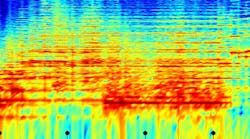Intermodulation distortion (IMD) needs to be measured in many scenarios, as it is often a critical parameter. For example, two-tone third-order intercept-point (IP3) testing is suitable for a number of applications. Yet it is not always the most effective approach to simulate the actual channel conditions of a multi-carrier system, which resembles bandwidth-limited white noise. In an application note titled “Noise Power Ratio Testing on a Budget,” Signal Hound describes a method to accurately characterize multi-carrier intermodulation performance.
A traditional noise-power-ratio (NPR) measurement consists of a broadband additive-white-Gaussian-noise (AWGN) source that spans the entire bandwidth of the actual test. A notch filter, which has a deep and narrow notch somewhere within this bandwidth, is also included in the test setup. Typically, the notch’s bandwidth is no greater than 10% of the total bandwidth. The noise power ratio is the ratio of the signal power density to the power density of the notch, which is a combination of thermal noise and intermodulation products. While a noise source and notch filter may work in some instances, an alternative approach can provide cost benefits while allowing flexibility.
For instance, a synthetic noise technique can be used to closely approximate the AWGN/notch filter method. This technique averages together several successive measurements using 1000-tone sets that have random phase relationships. A vector signal generator (VSG) with a 100-MHz bandwidth can provide the capability required to measure NPR with the synthetic noise method.
The capabilities of Signal Hound’s VSG25A model are discussed in further detail. This VSG can be used with the BB60C spectrum analyzer to perform NPR measurements. For a 1001-tone test, the combined instruments have a noise level of about 40 below the signal without a device-under-test (DUT). This is sufficient for accurate NPR measurements to about 42 dB. The application note concludes with a step-by-step overview of the NPR test method, which provides users with a reference that can be used when performing this measurement.
Signal Hound, 35707 NE 86th Ave., La Center, WA 98629; (800) 260-8378
